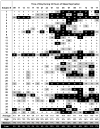Fitness for duty: a 3-minute version of the Psychomotor Vigilance Test predicts fatigue-related declines in luggage-screening performance
- PMID: 21912278
- PMCID: PMC3190077
- DOI: 10.1097/JOM.0b013e31822b8356
Fitness for duty: a 3-minute version of the Psychomotor Vigilance Test predicts fatigue-related declines in luggage-screening performance
Abstract
Objective: To evaluate the ability of a 3-minute Psychomotor Vigilance Test (PVT) to predict fatigue-related performance decrements on a simulated luggage-screening task (SLST).
Methods: Thirty-six healthy nonprofessional subjects (mean age = 30.8 years, 20 women) participated in a 4-day laboratory protocol including a 34-hour period of total sleep deprivation with PVT and SLST testing every 2 hours.
Results: Eleven and 20 lapses (355-ms threshold) on the PVT optimally divided SLST performance into high-, medium-, and low-performance bouts with significantly decreasing threat detection performance A'. Assignment to the different SLST performance groups replicated homeostatic and circadian patterns during total sleep deprivation.
Conclusions: The 3-minute PVT was able to predict performance on a simulated luggage-screening task. Fitness-for-duty feasibility should now be tested in professional screeners and operational environments.
Figures







References
-
- Dinges DF, Mallis M. In: Managing fatigue by drowsiness detection: can technological promises be realized? Hartley L, editor. Pergamon; 1998. pp. 209–229.
-
- Gilliland K, Schlegel RE. Readiness to perform: A critical analysis of the concept and current practices. Office of Aviation Medicine, Federal Aviation Administration; 1993.
-
- Dinges DF, Powell JW. Microcomputer analysis of performance on a portable, simple visual RT task during sustained operations. BehavResMethods InstrumComput. 1985;6:652–655.
-
- Lim J, Dinges DF. Molecular and Biophysical Mechanisms of Arousal, Alertness, and Attention Annals of the New York Academy of Sciences. Oxford: Blackwell Publishing; 2008. Sleep deprivation and vigilant attention; pp. 305–322. - PubMed
Publication types
MeSH terms
Grants and funding
LinkOut - more resources
Full Text Sources
Other Literature Sources
Medical

